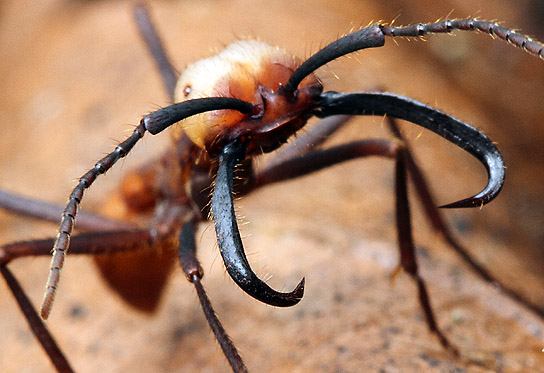In the dense jungles of Belize, a small but formidable force of nature marches relentlessly, leaving a trail of efficiency and awe in its wake. These are the Army Ants, masters of swarming and predatory tactics that have earned them a fearsome reputation in the insect world. With their highly organized attacks and the ability to strip an area of prey within hours, Army Ants showcase nature’s raw power and the intricate balance of life in Belize’s ecosystems. Join us as we delve into the fascinating world of Army Ants in Belize, uncovering their strategies, impact, and significance in the local environment.
The Swarm: Understanding Army Ants’ Highly Organized Attack Strategies
Army Ants are renowned for their swarming behavior, a spectacle that showcases their highly organized attack strategies. This organized chaos begins with scout ants venturing out from the colony in search of food. These scouts communicate through pheromones, laying down scent trails that guide the rest of the colony to the food source. Once a suitable target is found, the scouts initiate a coordinated response that sets off a chain reaction within the colony.
As the scouts return to the colony, they recruit more ants to join the raiding party. This recruitment process is swift and efficient, with ants of various castes, including workers, soldiers, and even the queen, joining forces for the raid. The sheer number of ants mobilized during a raid is staggering, often numbering in the hundreds of thousands or even millions, creating a moving carpet of relentless hunters.
During the raid, Army Ants exhibit remarkable coordination and teamwork. They form phalanx-like formations, with soldiers positioned on the periphery to defend against threats while workers swarm over the target area, dismembering and carrying off prey with remarkable speed. This division of labor ensures maximum efficiency, allowing the colony to exploit resources swiftly before moving on to the next target.
What makes Army Ant raids particularly impressive is their adaptability. These ants can adjust their raiding patterns based on environmental conditions and prey availability, displaying a level of intelligence and flexibility that belies their small size. This adaptability is crucial for their survival in the ever-changing landscapes of Belize, where food sources can be unpredictable.
In essence, the swarm of Army Ants represents a symphony of cooperation and strategic prowess, highlighting nature’s ingenuity in harnessing collective action for survival and success in the harsh realities of the jungle.
Efficiency in Action: How Army Ants Strip Areas of Prey in Record Time
Army Ants are not only masters of organization but also exemplars of efficiency when it comes to stripping areas of prey. Their ability to swiftly exploit resources has earned them a reputation as nature’s efficiency experts, capable of clearing an area of all edible matter in a remarkably short time frame.
The key to their efficiency lies in their relentless foraging behavior. Army Ant colonies are constantly on the move, never staying in one location for too long. This nomadic lifestyle is driven by the need to find new food sources to sustain the massive colony population. When a food source is discovered, whether it’s a fallen insect, a nest of termites, or even a small animal, the colony springs into action with unparalleled speed.
During a raid, Army Ants employ a combination of speed, strength, and teamwork to overwhelm their prey. Workers swarm over the target, quickly dismembering and carrying off pieces of the prey. Soldiers stand guard, ready to defend against any threats or attempts by the prey to escape. This coordinated effort ensures that the colony can extract as much food as possible before moving on to the next location.
What sets Army Ants apart is their ability to leave no stone unturned. They are thorough in their search for food, combing through every crevice and leaf litter in their path. This thoroughness ensures that they extract maximum resources from each raid, minimizing waste and maximizing efficiency.
Their efficiency is also evident in their adaptability to different prey types. Army Ants can prey on a wide range of creatures, from small insects to larger arthropods and even small vertebrates. This versatility allows them to exploit a variety of food sources, further enhancing their efficiency in resource utilization.
In the world of Army Ants, time is of the essence, and their ability to strip areas of prey in record time showcases the remarkable efficiency of nature’s most organized hunters.
Belize’s Ecological Balancing Act: The Impact of Army Ants on Local Ecosystems
In the intricate tapestry of Belize’s ecosystems, Army Ants play a vital role as both predators and ecosystem engineers, shaping the dynamics of their habitats in profound ways. Understanding the impact of these relentless hunters sheds light on the delicate balance that exists within the natural world.
One of the most significant contributions of Army Ants to their ecosystems is their role in pest control. As voracious predators, they help keep populations of insects and other invertebrates in check. This pest control service is especially valuable in agricultural areas, where pests can threaten crops and livelihoods. By preying on pests, Army Ants indirectly benefit human communities by reducing the need for chemical pesticides.
Furthermore, Army Ants’ foraging behavior contributes to nutrient cycling and soil health. As they move through the environment, they disturb leaf litter and soil, aerating the ground and promoting decomposition. This activity enhances nutrient availability for plants and other organisms, ultimately contributing to the overall health of the ecosystem.
Despite their predatory nature, Army Ants also serve as prey for a variety of other species. Birds, reptiles, amphibians, and even certain mammals rely on Army Ant raids as a source of food. This interdependence highlights the interconnectedness of species within Belize’s ecosystems, where each organism plays a role in the web of life.
However, the impact of Army Ants is not without challenges. Their swarming behavior can be disruptive to smaller organisms and may lead to localized declines in certain prey populations. Additionally, their nomadic lifestyle means that they can quickly deplete resources in a particular area before moving on, creating temporary fluctuations in local biodiversity.
Overall, Army Ants in Belize represent a fascinating example of nature’s complex web of interactions. Their presence influences the distribution and abundance of other species, shaping the dynamics of ecosystems and highlighting the delicate balance that sustains life in this diverse region.
Final Thoughts
Army Ants in Belize are not just tiny creatures scurrying through the jungle; they are architects of ecosystems, sculptors of biodiversity, and masters of efficiency. As we wrap up our exploration of these fascinating insects, several key reflections come to mind.
Firstly, Army Ants exemplify the intricate balance of predator-prey relationships in nature. They are formidable hunters, yet they also serve as vital food sources for numerous other species, highlighting the interconnectedness and interdependence of life forms within Belize’s ecosystems.
Secondly, their nomadic lifestyle and relentless foraging contribute to the health and functioning of the environment. By controlling pest populations, promoting nutrient cycling, and serving as prey for higher trophic levels, Army Ants play multifaceted roles that contribute to the overall resilience and vitality of the ecosystem.
However, it’s essential to recognize the challenges and complexities that come with their presence. Army Ant raids can disrupt local populations of smaller organisms and lead to short-term fluctuations in biodiversity. Their rapid exploitation of resources also underscores the need for sustainable management practices to ensure the long-term health of ecosystems.
In conclusion, studying Army Ants in Belize offers valuable insights into the intricate workings of natural systems. Their behaviors, impacts, and interactions with other species paint a rich tapestry of life in the jungle. As we continue to explore and appreciate the wonders of biodiversity, let us also strive to conserve and protect these delicate balances that sustain life on our planet.




